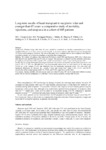Mostrar o rexistro simple do ítem
Long-term results of heart transplant in recipients older and younger than 65 years: a comparative study of mortality, rejections, and neoplasia in a cohort of 445 patients
| dc.contributor.author | Crespo-Leiro, María Generosa | |
| dc.contributor.author | Paniagua-Martín, María J. | |
| dc.contributor.author | Muñiz, Javier | |
| dc.contributor.author | Marzoa Rivas, Raquel | |
| dc.contributor.author | Piñón-Esteban, Pablo | |
| dc.contributor.author | Rodríguez-Fernández, José Ángel | |
| dc.contributor.author | Hermida, L.F. | |
| dc.contributor.author | Calviño-Santos, Ramón | |
| dc.contributor.author | Cuenca, José J. | |
| dc.contributor.author | Juffé-Stein, Alberto | |
| dc.contributor.author | Castro-Beiras, Alfonso | |
| dc.date.accessioned | 2015-10-16T07:10:53Z | |
| dc.date.available | 2015-10-16T07:10:53Z | |
| dc.date.issued | 2005-12-28 | |
| dc.identifier.citation | Crespo-Leiro MG, Paniagua-Martin MJ, Muñiz J, Marzoa R, Piñón P, Rodríguez JA, et al. Long-term results of heart transplant in recipients older and younger than 65 years: a comparative study of mortality, rejections, and neoplasia in a cohort of 445 patients. Transplant Proc. 2005;37(9):4031-4032 | es_ES |
| dc.identifier.uri | http://hdl.handle.net/2183/15370 | |
| dc.description.abstract | [Resumen] Background. Whether being older than 65 years should be considered an absolute counterindication to heart transplant (HT), as it is in some centers, is controversial. In our centre, patients older than 65 years are accepted for HT if they satisfy stringent conditions. The aim of this study was to examine whether heart recipients older than 65 years have a greater risk of rejection, neoplasia, or mortality than younger ones. Methods. We studied 445 patients who underwent HT between April 1991 and December 2003, 42 of whom were older than 65 years and 403 who were 65 years or younger. The parameters evaluated were the cumulative incidences of neoplasias and rejections (ISHLT grade ≥ 3A), and the survival rates 1 month, 1 year, and 5 years post-HT. Results. The two groups had similar percentages of patients with at least one rejection episode (≤65 years 56.9%, >65 years 51.3%; P > .05), and although there were proportionally almost twice as many tumors in the older group (14.2%) as in the younger (7.9%), this difference was not statistically significant either. Nor were there any significant differences in survival, the 1-month, 1-year, and 5-year rates being 87.8%, 82.1%, and 68.8%, respectively, in the younger group and 85.7%, 78.6%, and 73.4%, respectively, in the older. Conclusions. Among carefully selected patients aged more than 65 years, HT can be performed without incurring greater risk of rejection, malignancy, or death than is found among recipients younger than 65 years. | es_ES |
| dc.language.iso | eng | es_ES |
| dc.publisher | Elsevier | es_ES |
| dc.relation.uri | http://dx.doi.org/10.1016/j.transproceed.2005.09.158 | es_ES |
| dc.rights | Creative Commons Licence | es_ES |
| dc.rights | Reconocimiento-NoComercial-SinObraDerivada 4.0 Internacional | |
| dc.rights.uri | http://creativecommons.org/licenses/by-nc-nd/4.0/ | |
| dc.title | Long-term results of heart transplant in recipients older and younger than 65 years: a comparative study of mortality, rejections, and neoplasia in a cohort of 445 patients | es_ES |
| dc.type | info:eu-repo/semantics/article | es_ES |
| dc.rights.access | info:eu-repo/semantics/openAccess | es_ES |
Ficheiros no ítem
Este ítem aparece na(s) seguinte(s) colección(s)
-
GI- GRINCAR - Artigos [226]






